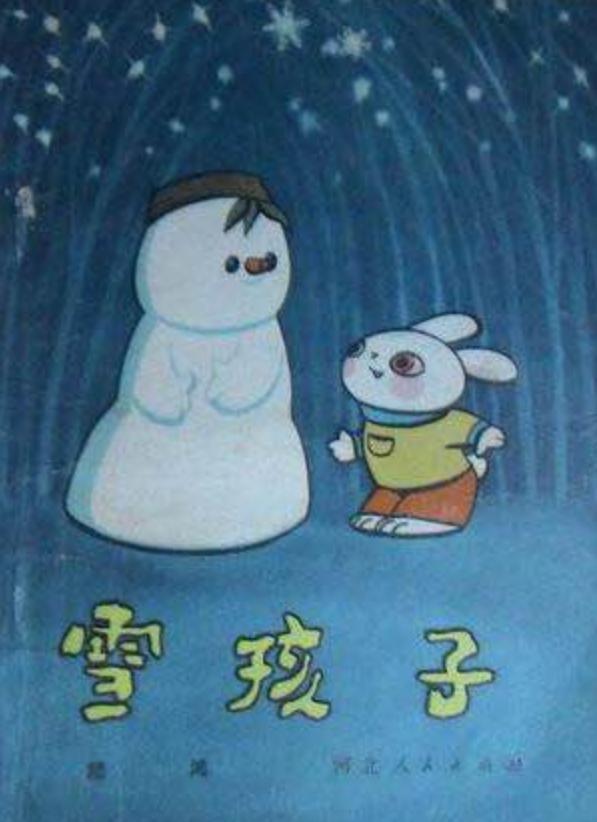Snow Child (雪孩子) (1980)
Filed under: Animation, 1980s, Anime, China, Painted Animation, Shanghai Animation Film Studio, Technicolor,
Snow Child (雪孩子)

Poster of Snow Child
Directed by: Animated by:Chang Guangxi (常光希, Character Design)
Lu Qing (陆青)
Qu Meikun (邬美坤)
Pan Jiyao (潘积耀)
Fu Feiqing (傅斐卿)
Yuan Suqin (袁素琴)
Jin Fuzai (金复载, Composer)
Zhu Fengbo (朱逢博, Singer)
Wang Yongji (王永吉, Orchestra Conductor)
Shanghai Film Orchestra (上海电影乐团, Instrument Performance)
Fang Pengnian (方澎年)
Jiang Aijian (江爱坚)
Shanghai Animation Film Studio (上海美术电影制片厂)
Release date:1980
Running time:21 min
Color process:Technicolor
Synopsis
A rabbit mother piled up a snow child as companion to her bunny before going out. The snow child and the bunny became friends, skiing and dancing on icy lake. Later, when the house was accidentally on fire, the snow child rescued the sleepy bunny out of it. But because of heat, the snow child melted completely into a pound of water. The child’s soul ascended to heaven after sun coming out, waving farewell to the crying bunny.
The animation was inspired by a story from a children’s book named 365 Ye Gu Shi (Story of 365 Nights) which was widely read in China. In the original story, friends of the bunny came to help putting off fire from the house, whereas in the anime, the Snow Child was the only one who rescued the bunny but was ultimately melted down due to high temperature.
This new emphasis on self-sacrifice was confirmed by the director during interviews: “the story was also realistic, the main theme being sacrificing oneself for others, a kind of moral education, so it was very optimistic…full of things that appeal to children, vivid and lively, lyrical and moving” (Lin, 73).
“The script ‘Snow Child’ was a submission received by our literature group. It was created by a middle school Chinese teacher. The literature group liked it after reading, so they sent it to me because they thought I was good at dealing with this sort of subject matter. After having read, I also thought it very good because it was natural and vivid. It didn’t expound something mechanically. We advocate making health-themed films, which is of educational significance to children. This is our purpose for creation.” (Sun, 73)
The director wanted to evoke warmth and empathy from children’s hearts after her seeing a group of children torturing a kitten without being aware of their cruelty. She considered the indifference as a result of the Cultural Revolution (1966-1976) when solidarity between people was destroyed (李, 2012).
There was also a continuous pursuit of nationalization as was what typical to early Chinese Animation. The artistic style of Snow Child was heavily inspired by traditional clay doll of Wuxi and woodblock prints from Weifang, Shandong (Lin, 73).
Snow Child was awarded with the Outstanding Film Award from Ministry of Culture of China in 1980 (中国文化部优秀影片奖). It is also the inspiration of a later animation series, Bunny Taotao, which was one of the earliest developments of Intellectual Property (IP) in the history of Chinese animation (郭, 86).
English Subtitles and Translation by Hanyan (Helen) Shen.
References:
Sun, Lijun, ed. The History of Chinese Animation. II. London: Routledge, 2020.
Wenxiao, Lin. “Chapter 4 Dribs and Drabs”. In Chinese Animation and Socialism, (Leiden, The Netherlands: Brill, 2021)
郭, 晔旻. “九色鹿,雪孩子,阿凡提:百花齐放的黄金时代.” 国家人文历史 (北京), November 1, 2022.
李, 宝传. “林文肖的动画世界.” 中国艺魂, 2012. https://bkimg.cdn.bcebos.com/pic/a08b87d6277f9e2f070880064966fe24b899a901553c?x-bce-process=image/watermark,image_d2F0ZXIvYmFpa2U5MzM=,g_7,xp_45,yp_55/format,f_auto
